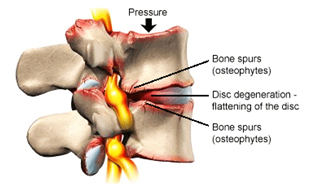Degenerative disc disease involves the intervertebral discs. Those are the pillow-like cushions between your vertebrae in your spine. They help your back carry weight and allow complex motions of the spine while maintaining stability. As you age, the discs can lose flexibility, elasticity, and shock absorbing characteristics. They also become thinner as they dehydrate. When all that happens, the discs change from a supple state that allows fluid movement to a stiff and rigid state that restricts your movement and causes pain.
If you are experiencing chronic back or neck pain, you may have degenerative disc disease. It commonly occurs in your low back (lumbar spine) or neck (cervical spine). Developing degenerative disc disease is a gradual process. As you can see in the illustration, there are even many stages and states your discs can go through as part of DDD. They can bulge, herniate, or thin. Because of disc changes, your vertebrae can be affected-you can see this in the illustration, too. For example, bone spurs (osteophytes) can form as your spine tries to adjust to the intervertebral disc changes.

Symptoms
The most common early symptom of degenerative disc disease is back pain that spreads to the buttocks and upper thighs. When doctors refer to degenerative disc disease, they are usually referring to a combination of problems in the spine that start with damage to the disc, but eventually affect all parts of the spine. Problems thought to arise from the degenerating disc itself include discogenic pain, and bulging discs.
Discogenic Pain – one of the most difficult spinal conditions to operate
Discogenic pain refers to pain caused by a damaged intervertebral disc. A degenerating disc may cause mechanical (or structural) pain. As the disc begins to degenerate, there is some evidence that the disc itself becomes painful. Movements that place stress on the disc can result in back pain that appears to come from the disc. This is similar to any other body part that is injured, such as a broken bone or a cut in the skin. When these types of injuries are held still there is no pain, but if you move them they hurt. Discogenic pain is usually felt in your lower back. The pain may also feel like it is coming from your buttocks and even down into your upper thighs. The experience of feeling pain in an area away from the real cause is common in many parts of the body, not just the spine. For example, a person with gallstones may feel pain in their shoulder, and a person having a heart attack may feel pain in their left arm. This is referred to as radiation of the pain because the pain radiates, or spreads out, to other parts of the body. It is very common for pain produced by spine problems to be felt in different areas of the body — including the back.
Bulging Discs
Bulging discs are fairly common in both young adults and older people. They are not cause for panic. Bulging discs are frequently seen in people with and without back pain. In some cases, bulging discs are part of both the aging process and the degeneration process of the intervertebral disc. A bulging disc is not necessarily a sign that anything serious is happening to your spine. A bulging disc only becomes serious when it bulges enough to cause narrowing of the spinal canal. If there are bone spurs present on the facet joints behind the bulging disc, the combination may cause narrowing of the spinal canal in that area. This is sometimes referred to as segmental spinal stenosis.
Seek immediate medical attention and call us anytime if:
- Pain is getting worse
- You have disabling pain
- Leg weakness, numbness, tingling
- Loss of bowel or bladder control.